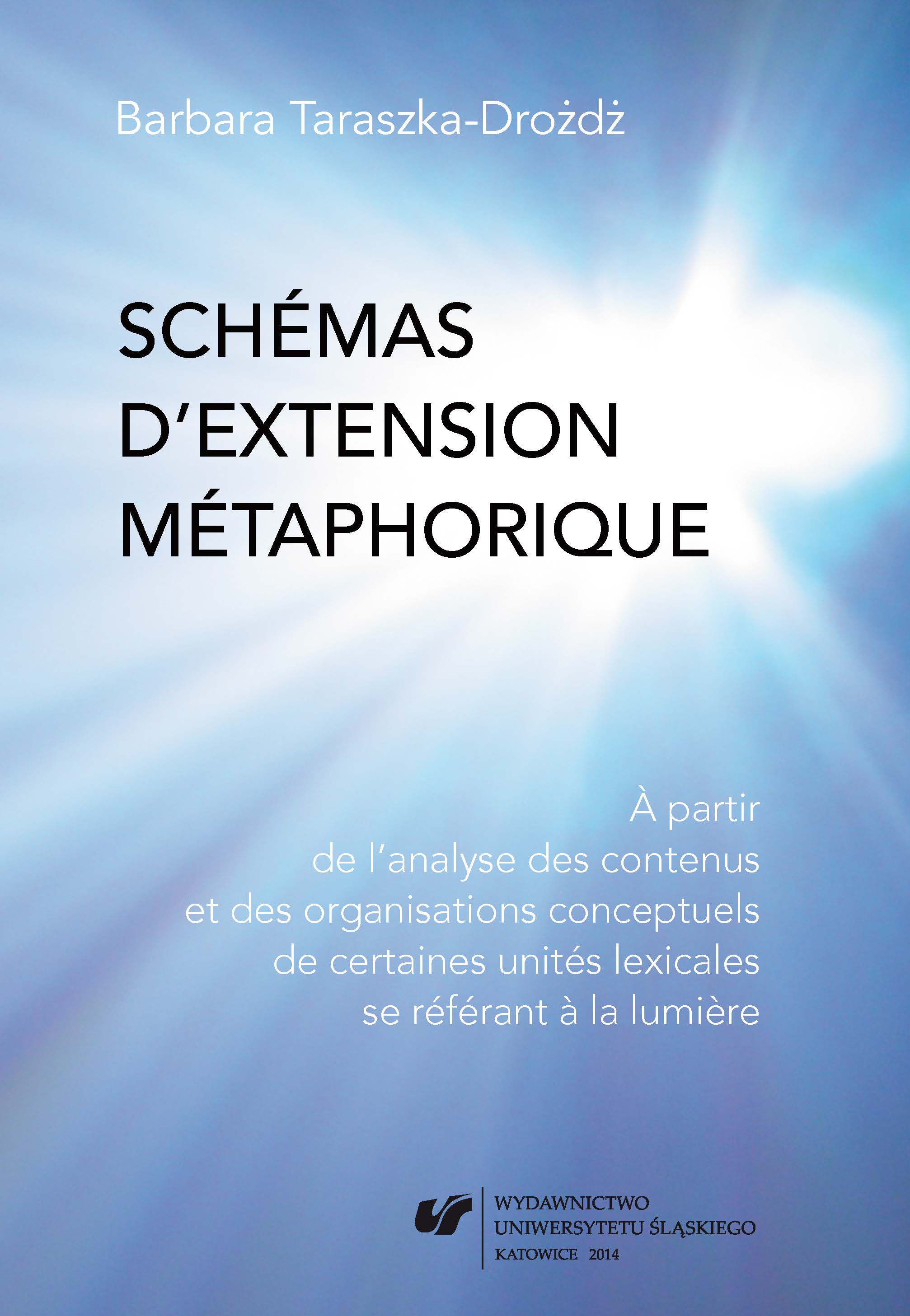Schémas d’extension métaphorique. À partir de l’analyse des contenus et des organisations conceptuels de certaines unités lexicales se référant à la lumière
Schemas of metaphorical extension. On the basis of analysis of the conceptual content and organization of selected lexical units referring to light
Author(s): Barbara Taraszka-Drożdż
Subject(s): Language and Literature Studies, Applied Linguistics, Sociology of Literature
Published by: Wydawnictwo Uniwersytetu Śląskiego
Keywords: cognitive linguistics
Summary/Abstract: The present work is situated within the paradigm of Cognitive Linguistics,whose major claim is that language constitutes an integral part of human cognition.This trend was created at the end of the 1970s and is represented by the work ofRonald Langacker, George Lakoff, Gilles Fauconnier, and Mark Turner. One of theareas of interest within this trend is the phenomenon of metaphor, which is also thesubject of the present thesis.The first, theoretical part, begins with an account of the basic assumptions ofthe Conceptual Metaphor Theory, which played a significant role in the study ofmetaphor. This theory was introduced by Lakoff and Johnson in the book MetaphorsWe Live By. In it, the authors also put forward a claim about the central role of metaphorin language and cognition. This theory has been both further developed bysuch scholars as Zoltan Kövecses, Joseph Grady, Raymond Gibbs, or Mark Turner,and also modified under the influence of the Blending Theory by Fauconnier andTurner. The second chapter of the theoretical part is devoted to the main assumptionsof Cognitive Grammar formulated by Langacker. Within this complex theoryof language, metaphor is primarily viewed as a type of semantic extension entailinga change of domain. The most significant role in such extensions is played by the abstract,schematic structures emerging from them. A juxtaposition of these two theoriesin the third chapter allows the author to observe the superiority of Langacker’stheory. It permits an account of the phenomenon of metaphor in all complexity —from metaphorical extensions of single linguistic units to highly schematic structurescalled patterns of metaphorical extension.The aim of the second part of the book is an application of Cognitive Grammartools to an analysis of metaphorical extensions of selected French lexemes. On thisbasis, the author arrives at the schematic structures emerging from these extensions.Taking into consideration one of the major claims of Cognitive Grammar — that allgeneralizations arise as schematizations of more specific structures — the researchbegins with an analysis of the conceptual content and organization of each of theselected items. The object of the analysis is the item lumière (light) and other selectedlexemes referring to light.At the first stage, the object of the analysis is these lexemes’ conceptual contentand the particular way of construing that content in the domain of visual perception,that is, the domain which constitutes the standard in the categorizing relationshipsdescribed in further parts of the publication. Due to an application of CognitiveGrammar tools, it is possible to point to similarities and differences between theanalyzed items at the level of their profile, base, and the immediate and maximalscope.The consequent analysis of the extensions of the above-mentioned items to otherdomains (auditory, intellectual, social, emotional, and moral) allows the author toarrive at a whole system of structures which are schematic in relation to these extensions.Among these, at the highest level of schematicity, the following patterns ofmetaphorical extension are enumerated: [WHAT CONCERNS LIGHT] ---> [WHATCONCERNS AUDITORY SENSATIONS], [WHAT CONCERNS LIGHT] ---> [WHATCONCERNS EXPERIENCES RELATED TO KNOWLEDGE AND UNDERSTANDING]and [WHAT CONCERNS LIGHT] ---> [WHAT CONCERNS EXPERIENCES INTHE EMOTIONAL AND MORAL SPHERE]. Each of the above patterns is describedalong with the matrix of domains which can be activated by particular extensionsas well as with the bodily and cultural knowledge constituting the background forthese extensions.With the adoption of Langacker’s definition, according to which metaphoricalextensions involve a change of domain, it is possible to call these schemas metaphoricalpatterns. However, the author notes important discrepancies concerning the relationsbetween the standard and target of the above patterns. These discrepancies,which are sometimes classified in the literature as metonymical or metaphorical, areapproached in the book by means of cognitive distance. The analysis also enablesthe author to make some observations concerning the axiological dimension whichcan be evoked by some of the patterns’ instantiations.
- E-ISBN-13: 978-83-8012-255-0
- Print-ISBN-13: 978-83-8012-254-3
- Page Count: 258
- Publication Year: 2014
- Language: French
- eBook-PDF
- Table of Content
- Introduction

